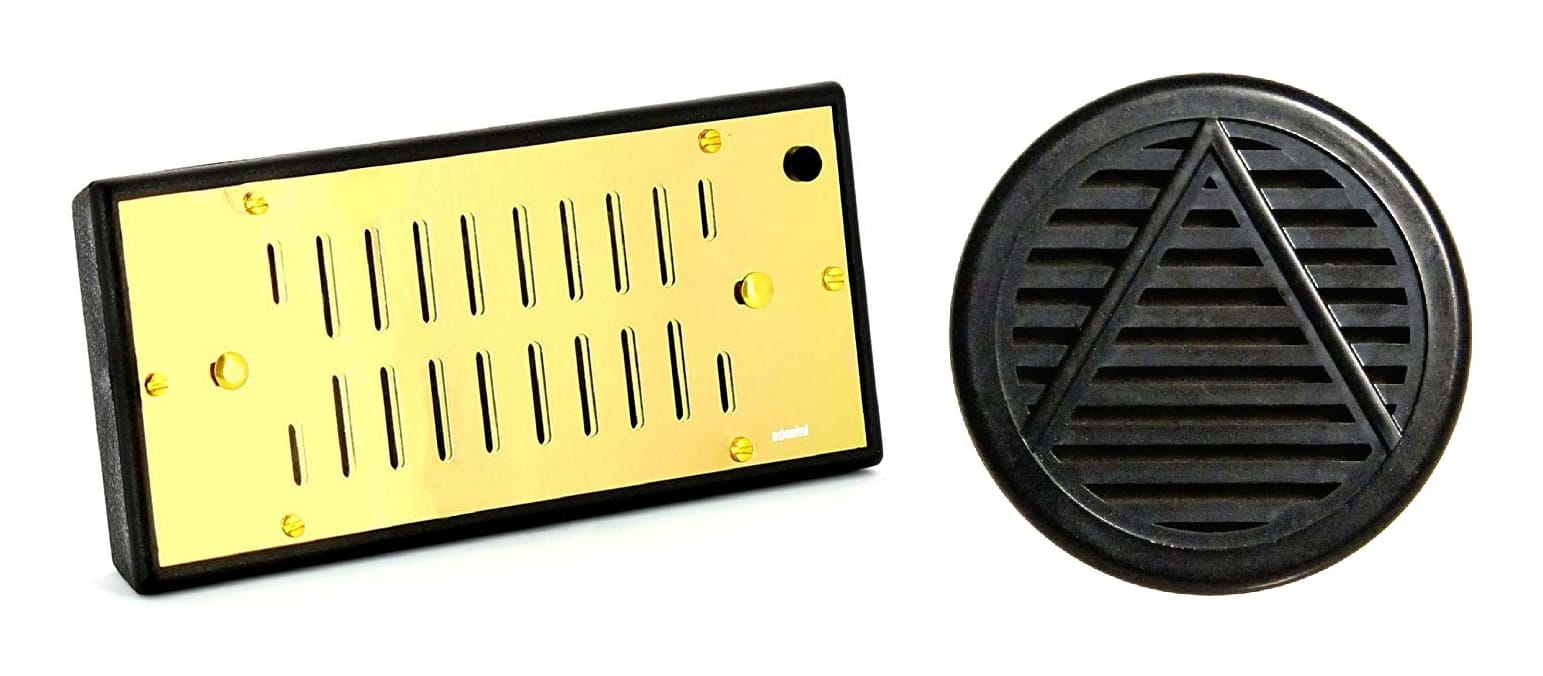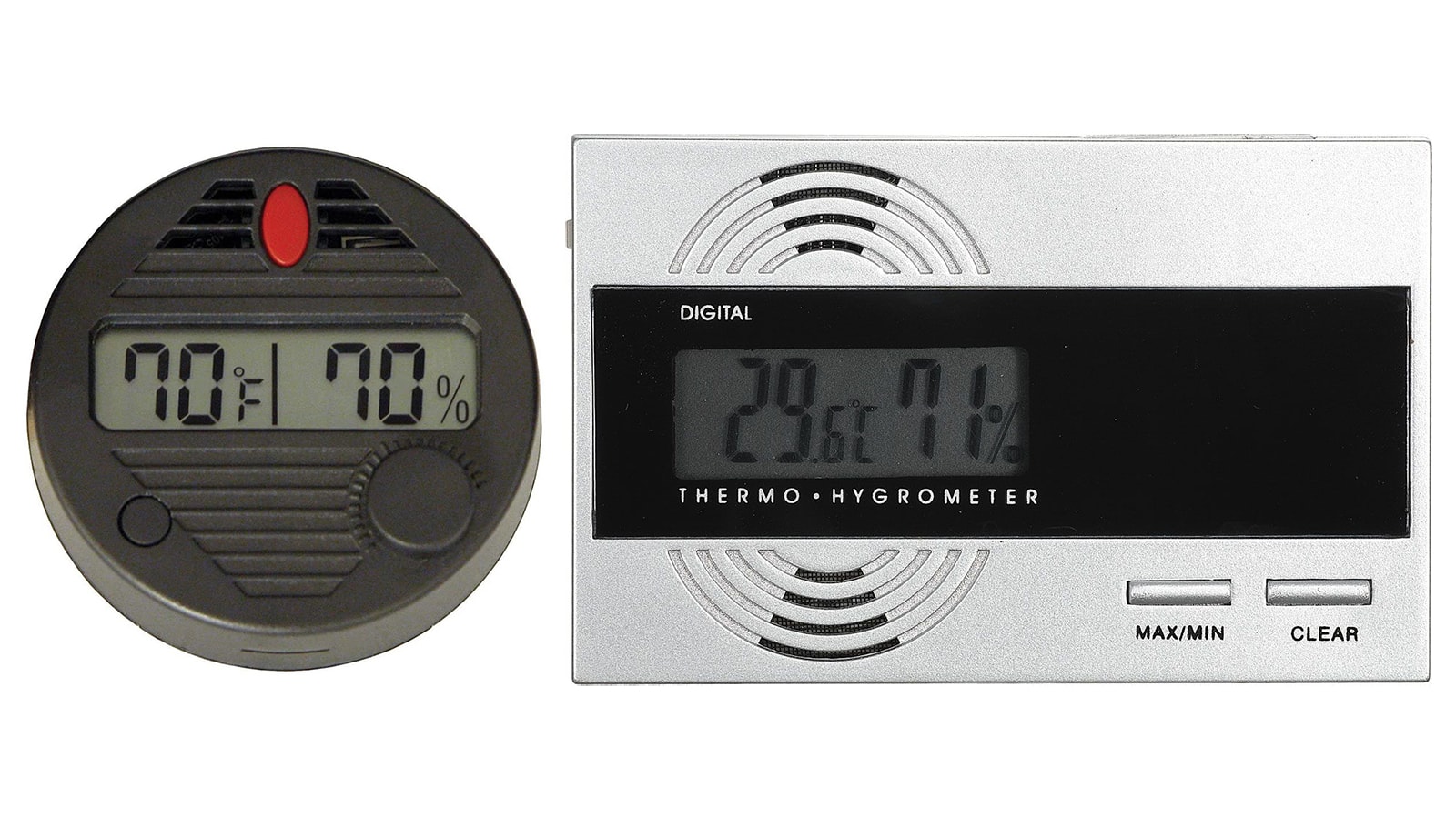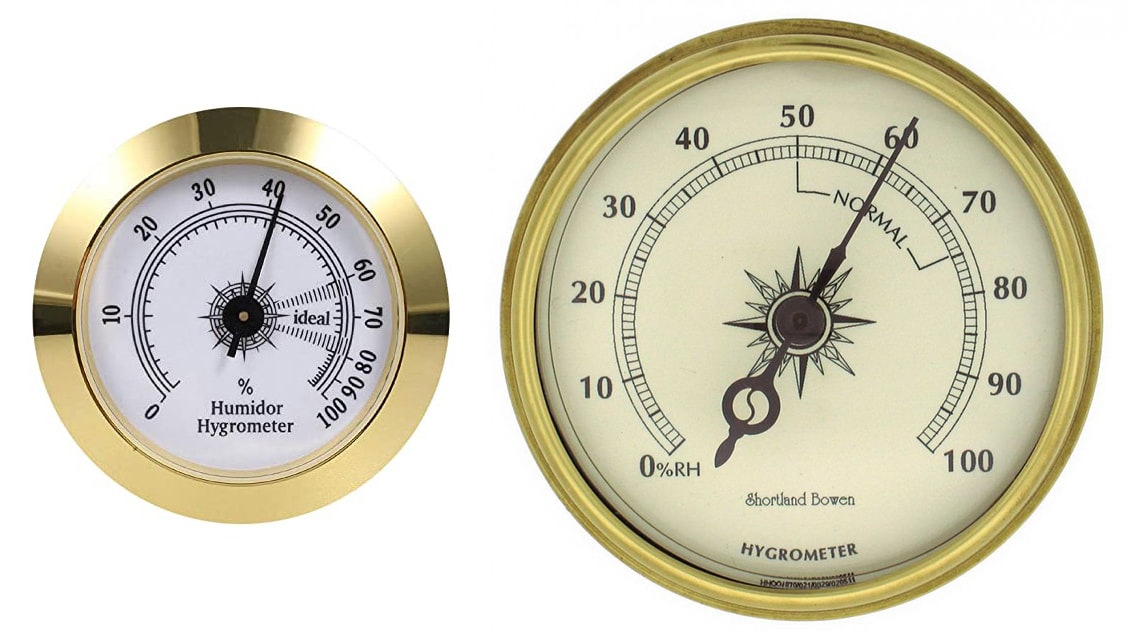In this guide you can fine all the informations regarding the humidification.
-
- How to start a humidor for the first time or quickly increasing the humidity
- Humidification devices: types and which ones to choose
- The humidity rates and the optimum humidity to keep in the humidor
- Devices for controlling humidification: hygrometers (types and which ones to choose)
- Problems related to inadequate humidification
- What to do if the humidity is not correct
START A HUMIDOR FOR THE FIRST TIME OR QUICLY INCREASE THE LEVEL OF HUMIDITY
To start using a humidor for the first time, or to raise the humidity level following a significant drop, you can proceed in several ways. Be careful not to raise the humidity too quickly if you have cigars in the humidor.
The fastest way is to take distilled water (distilled water is used because it does not contain bacteria), put it in a cup (or in a container, based on how large is the volume to humidify), and place it in the humidor. In addition to this it is good to also pass a damp cloth (again, always using distilled water) on the surfaces of the humidor. In this way you will speed up the process. When the humidity has risen, remove the cup and insert the humidification devices.
HUMIDIFICATION DEVICES
Many are the type of humidification devices. Sponges, polymer crystals, propylene glycol, Boveda and beads can be used. Currently, the system that we consider the best are the beads. They initially cost more, but once purchased they last forever. Boveda and beads act in 2 ways: they increase the humidity level, if this is too low, and they decrease it if it is too high. When buying, you can choose the humidity rate. Following is instead is the classic sponge that is found in small humidors (in more and more cases, polymers are used instead of the sponge):

There are also more technological systems for humidity control (electronic humidifiers), but they are usually used for larger humidors.
HUMIDITY RATES AND OPTIMAL HUMIDITY
What is the best humidity? There is no exact answer to this question. It depends on the type of cigars and on your palate. Here are some ranges, based on the type of cigars:
- Cuban cigars: we suggest a humidity from 60% to 72% humidity. Below 60% the cigar begins to become dry, while above 72% it becomes too humidified. The advice, for these cigars, is a rate between 65 and 68%.
- Caribbean cigars: for cigars that are produced in Nicaragua, Dominican Republic, Honduras etc. slightly higher humidity rates are used than those for Cubans. The range varies from 65% to 75%. Having that said, our palate is the best for judgment.
- Italian or Kentuky cigars: for the Toscani and for the kentuky cigars the humidity percentage is different. These cigars are smoked even if not kept in a humidity controlled environment. However, the smoking performance is much lower than that of correctly humidified cigars. The humidity range is low: between 55% and 70%, but often many Italian cigar smokers do not exceed 65%.
HUMIDITY CONTROL DEVICES
There are many devices on the market that allow humidity control. From the simplest and oldest analog hygrometers, to the most modern electronic ones. Basically they all have the same purpose and can be considered valid.
For reasons of space, electronic hygrometers are smaller and are also able to measure temperature (which never hurts). For safety, the advice is to keep at least 2 of them in the humidor; this for a better control and because there may be a slight difference between the areas in the humidor. In the upper part, usually, the humidity is slightly lower.

Analog hygrometers are usually cheaper, but also more voluminous. They must also be adjusted before using them.

To perform the calibration (in the hygrometers allowing this) it is sufficient to carry out a very simple procedure:
- take an airtight container (like kitchen tupperware) and put the hygrometer inside;
- take a coffee cup and fill it almost completely with fine salt. In the cup put a few drops of water so that the salt dissolves. Pay attention to not make the mixture not too liquid;
- place the coffee cup in the airtight container together with the hygrometer and close the lid.
- wait a few hours (1-2 hours are enough) for the analog hygrometers and 10 minutes for electronic ones. Open the lid and what the hygrometer should mark is 75% humidity. If not, with a screwdriver you can adjust it through the screw that is usually placed on the back.
Alternatively, a more volatile and safe procedure is to use the boveda calibration kit.
The same procedure can also be followed for electronic ones, which usually have an error range of 1-3%. It is also a good idea to mark the difference in humidity measured on the hygrometers, in order to always have a reference for reliable measurement.
PROBLEMS RELATED TO INADEQUATE HUMIDIFICATION
When cigars are not stored properly, the smoking experience can be partially or totally compromised. The most frequent cases related to “bad conservation” are:
- low humidity: the cigar is dry. By drying it loses its own oils and, consequently, it loses much of its aroma. Once ignited, the smoke will be not that “flavorful” and if it has not been rehumidified, the cigar will overheat easily as it will burn too quickly. It must be said that, even if re-moistened, the cigar will not regain the lost aromas. The level of deterioration depends on how long the cigar has been exposed to the low humidity. The temperature, in this case, can increase or decrease how fast the deterioration process will be: with a low humidity and a high temperature, the cigar will lose its oils faster. With a low temperature and low humidity, damage will occur more slowly. If you are not in extreme conditions, a cigar can be exposed to conditions that are not favorable to it for a certain period of time (even days). It is recommended to rest a cigar in the humidor for a period of time at least equal to that of “bad conservation”. For example, if a cigar has been out of the humidor for a week, it is better to store it one week before smoking it. However, care must be taken to avoid excessive swings in humidity. If a cigar is dry enough, it should not be placed in an already properly humidified environment: the cigar is like a sponge, and therefore will tend to absorb a lot of humidity in a short period of time. This will cause the cigar to swell and damage the wrapper leaf. If this happens, the smoke will be compromised. Usually what happens is the breaking of the wrapper in the cigar foot area. When you see cigars that have cuts on the foot, you are seeing damages that are, for the most part, caused by quick changes in humidity or by a too high humidity storage. The advice is therefore to put the cigar in a slightly humidified box and place it inside the humidor, so that its re-humidification is gradual and not sudden.
- high humidity: the cigar absorbs too much moisture. This causes it to swell too much and, as previously written, wrapper damages can occur. In addition, too high humidity can also lead to mold and fungus, which will ruin the cigar. If you light a cigar too much humidified, this will deliver a bitter smoke, not pleasant at all. A cigar kept in a too humidified humidor room be placed in a humidor so that its optimal humidity condition is restored. Also in this case, it is important to limit big variations, but lowering the humidity need to be gradual.
- temperature changes: temperature and humidity are closely related to each other. For this reason we must avoid that in our humidor the temperature undergoes sudden changes in a short period of time. This in fact would also lead to a change in the humidity rate. If the temperature drops quickly, condensation would form in the humidor, which is very dangerous as it lowers the humidity level, transforming moisture into water droplets. The stronger the condensation, the more water will form, and the higher the risk of literally wetting cigars. A rapid increase in temperature, on the other hand, would lead to an increase in the humidity in the humidor and consequently to the problem of hyper humidification (previously discussed).
WHAT TO DO IF THE HUMIDITY IS NOT CORRECT
The main cases are 2: humidity too high or humidity too low.
- humidity too low: proceed by checking that the humidification devices are working, or that there is water inside them. If there is no water, replenish them. If, on the other hand, water is present, then their humidification capacity is probably not enough. An additional humidification device must therefore be added, or the used one must be replaced with one of greater capacity. The environment in which the humidor is placed must always be considered. If the humidor is in a dry room, it will be easier for the humidity to tend to drop (even just opening the humidor would in fact create a loss of humidity). It should therefore be kept in mind and one should try to avoid opening the humidor too often and for a long period of time. One trick that can be used is to increase the amount of wood in the humidor: inserting empty boxes, or inserting (in the case of small humidors) wooden strips (those found in cigar boxes, used to separate the 2 rows of cigars are perfect).
- humidity too high: proceed by removing the humidification devices from the humidor. If the humidity lowers and reaches the desired level, then you must be careful about the amount of water you placed in these devices, perhaps you added to much. If the humidity does not drop, you can leave the humidor open (leaving the humidification device in it), so that the excess moisture will come out. How long to leave the humidor open? It depends. It can take 15 minutes, but it can take up to an hour or a day in the worst case. It depends on how high the humidity is, how much wood the humidor is made of (the more wood, the more time it takes for it to release its humidity), and the humidity in the room in which the humidor is placed (if it is very humid even if you keep the humidor open you will not change the situation that much).
Another problem is the keeping the humidity level constant. This can be solved by using devices that are capable of releasing and absorbing humidity.

